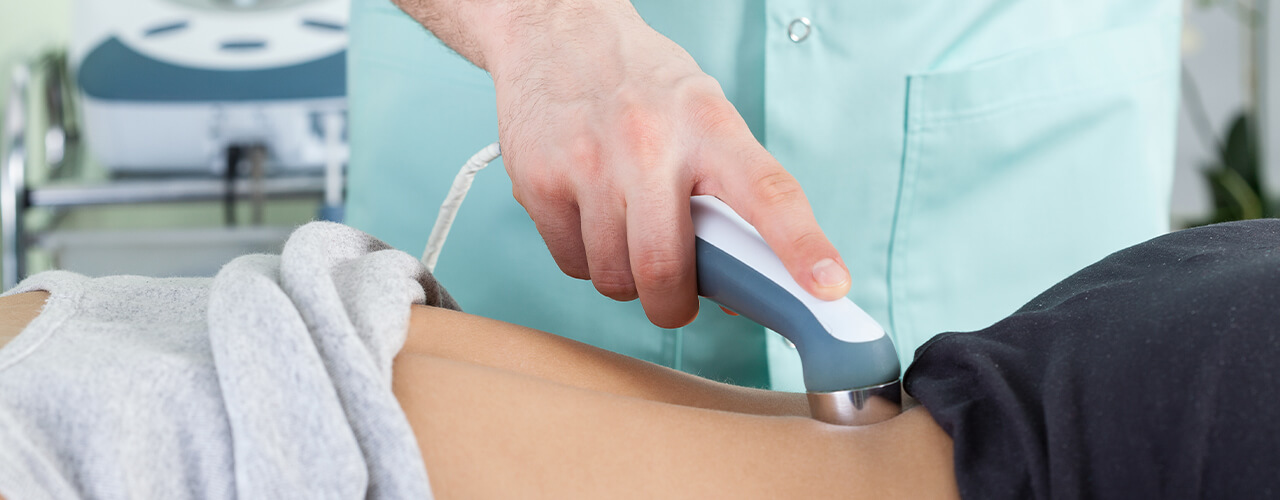Ultrasound is a method of treatment using mechanical energy that has been used for quite some time by physiotherapists to relieve pain and promote healing. Our Vancouver physiotherapists are highly trained in the use of ultrasound and there are several specific ways in which this type of treatment may be used to treat your injury and reduce your pain.
Do you want to learn more about how it can provide pain relief, promote healing, and improve your ability to perform daily tasks and activities? If so, contact Physiomed today.
How does ultrasound work?
Ultrasound uses sound waves to treat a vast variety of conditions that affect the bones, muscles, and ligaments. These sound waves create vibrations that generate heat. When the tissues vibrate, friction is produced at a molecular level that causes the temperature of the tissues to rise, which relieves pain and inflammation. This is one of the greatest benefits of ultrasound therapy – it can penetrate deep into the tissues in ways that a hot pack cannot.
This therapy is performed by placing the applicator to the affected area of the body, with gel on the surface as a way to minimize friction and promote the transmission of the waves. The affected tendons, ligaments, and connective tissues will absorb these waves and the healing process will be facilitated.
How does ultrasound affect the body?
Ultrasound therapy has two specific ways that it heals and repairs damaged tissues – through thermal and nonthermal benefits:
Thermal.
When using ultrasound, heat enters the tissues at a deep level. This can increase circulation while reducing pain. Heat can also enable muscles to more easily stretch. Thermal energy produced by this during physiotherapy can therefore loosen tight muscles and tendons.
Non-Thermal.
This also works in specific ways that are unrelated to the transfer of heat. When energy enters the body through ultrasound it creates tiny gas bubbles that gather around the tissues. These bubbles contract and expand at a rapid pace. This is called cavitation.
Will ultrasound treat my condition?
There are a wide range of conditions that ultrasound has been known to treat. Some of the most common include:
Osteoarthritis and rheumatoid arthritis.
These are chronic conditions that respond well to the deep heat provided by this.
Muscle spasms.
Heat applied at various places on or near the site can help relax the muscles and decrease spasms.
Muscle strains and tears.
The use of ultrasound therapy can reduce the number of time sprains, strains, and tears take to heal.
Bone fractures.
Healing of bone fractures can be promoted by the use of low-intensity ultrasound. Ultrasound has also been found to be a more cost-efficient and less invasive tool for diagnosing certain types of stress fractures.
Bursitis and tendonitis.
Frozen shoulder is a form of bursitis that can be effectively treated with This therapy.
How will ultrasound therapy benefit me?
Promote tissue healing.
Ultrasound not only improves your muscles and joint range of motion, but can aid in the healing of wounded tissues. The metabolism of the cells in the tissue are affected by this. The vibration produced by the ultrasound can help prevent scar tissue from forming.
Reduce swelling and inflammation.
Ultrasound therapy has been shown to reduce stiffness in muscles and joints while increasing range of motion. Once blood flow is increased and swelling and inflammation is reduced, this will allow your muscles and joints to respond more favorably to manual stretching exercises and different types of massage.
Increase blood flow.
Just as cold decreases blood flow, heat increases it. this therapy will cause your blood vessels to increase in size and therefore increase the blood flow. Increased blood flow means more nutrients will be delivered to the area of your injury while waste is carried away. This ultimately enhances the healing process.
Contact Physiomed to learn more about ultrasound therapy:
Our Vancouver physiotherapists have extensive knowledge and experience using ultrasound therapy to treat and relieve conditions. There are a variety of different techniques that our team of physiotherapists is educated on, and after a comprehensive exam, our physiotherapist will determine which one is best for you. It is likely that your treatment plan will include additional pain-relief and techniques in addition to ultrasound, including targeted stretches, exercises, or massage.
At our Vancouver physiotherapy practice, we have one goal: to alleviate your symptoms and help you heal. By doing so, this will improve your strength, flexibility, range of motion, and overall mobility. Our physiotherapist will also work with you to help you avoid re-injury in the future. If you are looking to regain your everyday function, contact Physiomed today. Ultrasound may be the answer for you!



